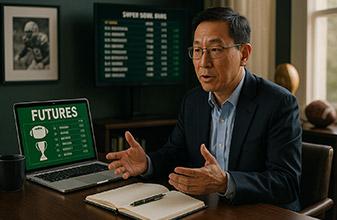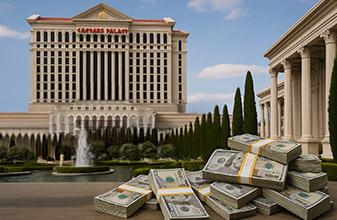Actually it is the tendency to repete results in general
Should you think that statistics predicts the future you are sadly mistaken. Statistics actually predicts the possibility of a result as a future history, looking backwards over results after a definite number of trials, hands or samples. This is known sometimes as the closed box assumption, or closed box problem.
Yet infinite goal ruin is never at the limits it is based on, never completes a definite number of trials, but always has been shown to be a reasonable limit to finite range results. But close examination never the less shows that so-called infinite goal ruin is actually an open box!
(1) It shows results before a limit or barrier is reached. Its results are within the box limits, but visible and calculable never the less.
(2) That it involves giving any ruin prediction, shows a subtle but important point about all statistical analysis: that all statistical predictions involve continuing to the end of a sample, EVEN WITH NEGATIVE bankrolls.
You always assume that you have kept on trucking if you will. So what is called ruin must really be considered the total probability of ranging below a bankroll level of zero. Those are actually important modifications to the usual understanding of the Central Limit Theorem!
All of the postings and writing of Schlesinger, Kim Lee, ML, and even the host of bjmath.com Reid, show an understanding of (1) above, but very little about (2). Chris Cummings brilliant endpoint trip ruin formula can be proven without (2) (as it is in the recent Gambling Conference paper Schlesinger so often refers to) but this understanding makes the process much easier.
Under assumption (2) the Cummings endpoint formula can be demonstrated with a negative bankroll---such as trying to play off a credit card balance before new interest charges kick-in--- and thus generalized. I am going to show a modified version of this, to keep the formulas in exponential form as well as explain this within the context of Samuelson's general infinite goal ruin.
Samuelson's formula is that infinite goal ruin is:
e^(-2*alpha), where alpha is the ratio between an optimal bankroll and your actual bankroll. This would make alpha then =B/EKB, where B is your actual bankroll and EKB the optimal number of units. EKB= (sd^2)/ev, where ev is the expected value. Then ruin becomes = e^(-2*B*ev/(sd^2))
If you then somehow wished to approximate (please note this is just an easy version, but similar to...) the probability of ending below a bankroll of zero, but only AFTER playing a given number of hands you would add in the expected value of playing that number of hands. Ruin then becomes= e^(-2*(B+(h*ev))*ev/(sd^2).
Schlesinger just moves the formula to a normal distribution form to be easier with modern spreadsheets.
The correlation between infinite goal results and finite results is sometimes called Euler's limit or E=(1-(1/SQR(h)). If we consider that the infinite goal formula times E is the probability of crossing zero within the box, since this so-called infinite goal formula is actually the open box estimate within the target number of samples, when adjusted, and that the Cummings formula gives the result at or after the target sample, then the total probability of crossing zero within h hands, or being ruined before h hands overall is:
E*[e^(-2*B*ev/(sd^2))+e^(-2*(B+(h*ev))*ev/(sd^2))] which is another form of Schlesinger trip ruin.
As far back as 1982 I had played with this WITHOUT trying to comeup with anything like the Cummings formula. I instead used the back and forth tendency of a given game directly, trading a narrower range of accurate estimates for some other important modeling. I called the ratio of the overall probability of crossing a barrier, to the endpoint probability, the RWI, or random-walk-index. I have had DD misquote some of his own results on this, and ML attack this because this approach and Don's approach, did not predict ruin where the number of hands was too small to actually have ruin possible. That is the level of attack I have faced from the so-called, "Schlesinger brain trust."
(They attack with the good purpose of moving debate, but sometimes the tactic subsumes the debate.)
This back and forth model is admittedly not accurate for a wide range of hands, but is important for generalizing how to combine ruin formulas for different ruin versus success or survival criteria, what I have tried to get called "ruin flavors."
A general combination of ruin flavors would estimate overall ruin to be=(r1+r2+....rn)*(1-r1)*(1-r2)....*(1-rn). If you wished to combine flavors of ruin, that involved one goal excluding another along the same line of results, you have to determine and isolate the terms that involve this back and forth tendency and not include them more than once. You would not adjust for going back and forth, which is the real precise cause for why finite goal ruin exceeds infinite goal ruin---each win or loss puts you forward or backwards in the spectrum of risk---more than once. This is easier to see with the RWI approach.
Now that I have shown however a derivation of Schlesinger trip ruin and how it can be extended, it is only fair to point out what went wrong with their understanding on these questions. It is also useful to have derived an exponential version simply because it is less risky to need a scientific calculator along, on your casino trips, than your laptop: rooms do get invaded when you are pulled up often!
But not realizing that you have significantly modified the Central Limit Theorem, by coming up with trip ruin, is appalling and only proves the clones to be credentialed empiricists rather than true theorists!
It is for example the closed box assumption of the CLT that has always been used to challenge Chebayev polynomial analysis, where exact results are predicted, from analysis of repetitive patterns in normal fluctuation, when a given level of fluctuations is known. Normal stock trading where a given group of trades is known will trigger certain "trading circuit breakers," is a well-known example of where fluctuations are known.
Well the clones as I call them missed out on scratching out the fundamental disproof of this group of theories.
I think the blackjack possibilities are clear too.
The fable possible explanation:
Another way to sum up this whole mess is suppose that you had a chip maker who had a formula for controlling the electron beam that cuts the masks for doping the chip blanks. Call him Dan Mudslinger. Dan insists that his formula is correct. Suddenly Dick Droop comes in and says that he did other early work on this, check it out. Dan says my formula works; any other is false; GTH; @$#@%, and has followers join in. Dick says that Dan's formula is bizarre in mixing in elements from various branches of math. Tests prove Dan's is best, but the same results show Dick's is close and has some edge's. Dan says, just what we need another damn electron aiming formula. Dick shoots back, remember Yeffremov. We didn't need a replacement for Maxwell either but simpler made stealth possible.
Then Dick comes up with a proof on why ALL of Dan's formula works. Dan is puzzled and once again replies @#$# etc. Dick then says, by the way, you really should know that that electron aiming formula is really a warp drive too. That is why it works so well.
Dan and clueless followers start a pitch-fork collection drive, and start buying gas cans, such that Wal-Mart runs out.
Just another day in blackjack!
The cause is the back and forth tendency that is easiest to see in Pascal�s triangle, as described in Hogben�s, Mathematics for the Million. Very quickly results tend to be those previously arrived at, such that all the chances of being at a result, as an endpoint, about match the previous times you have been at that same result level.
The Cummings hands survival formula is, is taking any of the usual derivations for ruin--see the Kriegman paper on bjmath.com-- and adding to the bankroll the expected profits (ev*h, h number of hands or trials) to comeup with a formula that gives the chance of being at or below zero bankroll AFTER so many hands. The only previous proof was in paper from a University of Minnesota professor, who equally missed the idea of demonstrating how it can apply to negative bankrolls. Showing how it can apply to negative bankrolls---ie what are my chances of winning enough to cancel a credit card debit is the example I used---provides a simple proof it works for AFTER so many hands, for ANY bankroll level.
Then you use what everyone has used for years as infinite goal ruin, except you treat it as it is derived, chances of being below zero WHILE playing forever, REALIZE that this infinite goal ruin is actually an open box formula, giving results short of the goal number of hands, to add-in the probability of being at a bankroll at or below zero before the target number of trials, in the way that you compare a finite result, to an infinite result.
Then you have a formula that gives you the total probability of being at or below zero, while keeping on playing through h hands no matter what. Overall then, but ONLY AFTER THESE STEPS, you also have a prediction of the total probability of running out of money while attempting to play h hands.
The SBT only explained this as a sort of tug of war, and one derivative equation surfaced that supposedly was posted somewhere by Don Schlesinger, that had 3 incorrect differential equation errors, and re-emailed to me, and reams of sims, but no theory whatsoever as to why this patchwork of ruin formulas should work at all.
It works only because the SBT had really stumbled across the insights (1)(on the closed box assumption being reversed for infinite goals) and (2) (on continuance in a random sampling process) and missing the significance of this.










